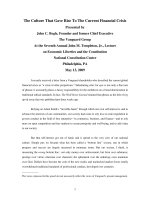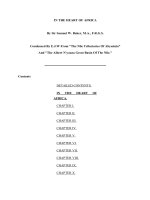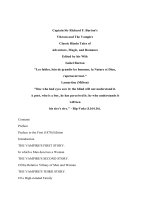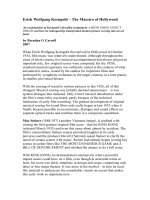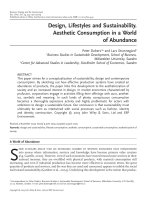RISE OF THE AESTHETIC EXPERIENCE AND THE PROCESS OF GLOBALIZATION ppt
Bạn đang xem bản rút gọn của tài liệu. Xem và tải ngay bản đầy đủ của tài liệu tại đây (262.07 KB, 8 trang )
1
RISE OF THE AESTHETIC EXPERIENCE
AND THE PROCESS OF GLOBALIZATION
ALEKSANDAR ČUČKOVIĆ
Faculty of Economics,
University of Novi Sad
SERBIA
Abstract: In recent years, the possibility of aesthetic experience is more common than ever, because the
different contents are being more and more invested with aesthetic properties. Although the term of “aesthetic
experience” overpowered the traditionally dominant concept of “beauty”, the value ascribed to it is disputable,
because the experience has repressed the object, but the growth of the aesthetic contents presence does not
correspond with a occasion to meet the most significant aesthetic values. The excellence of art has been merged
in the banality of everyday life, which obtained an attractive appearance, but not the beauty of spirit, lovable
surface, but not the true depth. As a strategy of turning of the unaesthetic to the aesthetic, aestheticization would
be more promising if it would not be reduced to the mere technique of beautification, but represented the trigger
for the legitimating of pervasive interference of all of the domains of rationality. The process of globalization
causes the weakening of the borders between different cultural domains, what makes their mutual interference
easier, but it cannot itself ensure the meaning of such integrations and take-overs.
Key words: Aesthetic Experience, Aestheticization, Globalization, Knowledge, Technology, Art,
Everyday Life
Today we meet many opportunities to experience something aesthetically. The reasons
for this are numerous and complex, especially if we have on the mind the process of
intensifying global interdependence of individuals, groups and states. In addition, some
changes have occurred in the nature of our expectations, our focus and our goals. Several
permanent features of our culture, in a broader sense, have a decisive impact on shaping of
our everyday life. The modern understanding of knowledge, the capitalist organization of the
economy, the rapid development of technology and the introduction of a series of regulatory
measures in many countries have a prominent place in this respect (Scholte, 2000:89). If we
add that the social significance of art and the nature of aesthetic experience were changed and
that we were meeting the increased presence of different aesthetic contents, we could see that
a considerable overlap between the structural factors that enable the process of contemporary
globalization and those that lie at the root of the phenomenon aestheticization were at work
for some time. Here it will be discussed mostly the nature of these two processes and their
(possible) relationships.
First of all, the modern times are established on the new conception of knowledge,
which presupposes the secularization of theory. This tendency went hand by hand with the
new organization of everyday life that was not focused on the heavens any more, but on the
earthly world. Namely, the fundamental change happened with the switching of man’s
understanding of his own role in the cosmos. From that moment on, anthropocentrism shaped
all man’s thoughts and actions. The divine creature became stand-alone creator and the planet
was no more experienced as the center of the universe, but as a home of the newly
emancipated being.
The only kind of knowledge that became acceptable was the one that has been
established by the scientific methods. In its quest for the “objective truth”, science became
the prestigious form of knowledge that was not exquisitely bound to the local cultural
tradition anymore, but started to be universally acceptable and valuable. Furthermore,
knowledge ceased to be considered as a result of the process of contemplation to become
understand as the condition of man’s power over nature: not a result, but starting point.
2
From now on we should not be preoccupied with eternal truths, but with the
immediate problems. On the other hand, anything connected with aesthetics, spirituality,
emotion or fantasy happened to be considered as “irrational” and acceptable only as a minor
condition of the advance of rational knowledge. Although any “primary truth” would never
be ascribed to these “irrationalities”, their presence would be in its own right. This rationalist
mindset would eventually provide the basis of modern legislation, bureaucratic organization
and social relations, from government, through firms, civic associations to schools, hospitals
and so on. Beside that, during the 18
th
century, the Enlightenment movement has promoted
cosmopolitism. For instance, Kant put forward the idea of the “world piece” that was founded
on the opposition of reason to any kind of the territorial division. At least, the courage of the
modern man to discard any authority except his own reason would eventually lead to the
aestheticization of the fundamental notions of his understanding: truth, reality and value.
In addition to this “intellectual base” of globalization and aestheticization, stand the
“material forces” such as: the new form of social order, new means of communication,
transport and data processing.
Technology has a crucial role in creating transworld social spaces and in establishing
a new space of the mediatized experience. The enormous series of technological inventions
and the introduction of the inventions into the common experience, such as the telegraph,
telephone, wireless, television, computer, railway, automobile, airplane, communication
satellite etc has changed our world forever. Global broadcasting, traveling and
communicating became the milieu of everyday life.
This development was enabled by the modern phenomenon that had come to being in
the integration of science and elaborated techniques. However, our life was not changed only
by the new possibility of using the refined technological devices, but by the fact that those
means had fundamentally transformed our notion of “purpose” (Borgmann, 1984:63).
Technology began to influence the entire concept of knowledge in return, especially its form
that is considered as the most prestigious – science, placing before it a request for
applicability.
During time, different techniques became systematized and integrated into a
comprehensive system of transferable cognitions, procedures and skills that acquired the
name of “technology”. This strategy strengthened the presence of different techniques in the
human world and ensured the consistency of their progress by leaps and bounds. In addition,
with the rise of capitalism, it was gradually adopted that every product of technology should
be supplied with certain aesthetic qualities. As any kind of transcendence has been losing its
power because of man’s modern rational emancipation, technology, which would eventually
become “high-tech”, began to fulfill this vacancy with the surrogates. The world experienced
as a magical unity has been dissolving from the beginning of human civilization: first religion
then art and at the end – technology represent only different kinds of effort to recreate that
lost unity.
As a way of production where economic activity is oriented first and foremost to the
accumulation of ever-greater resources in excess of the capital owners survival needs,
capitalism opposes to the earlier forms of economy, where no surpluses aroused or any
surplus was immediately consumed. The mechanism of capitalism is that surpluses are
invested in further production, with the aim of acquiring additional surplus and so on. In
short, capitalism is a type of social order in which a given way of producing and allocating
use-values is embedded.
In addition, the capitalism is changing in such a way that, in the recent time, many
firms have pursued global markets as a means to increase their sales volume. That led to the
development of the economies of scale and initiated the spreading of distribution and the
forming of sales networks and of global communications infrastructures to support them.
3
Finding the territories with lesser production costs and lower taxes, with the production of
global commodities with global price regulation became the urgent strategy of every
multinational corporation.
Various legal and institutional arrangements were subdued to a change. First of all,
much of the regulation was transferred from national states to regional and transworld
organizations, which have been formed by the states themselves and then given certain
autonomy. In short, the owners of capital urged the development of various schemes of so-
called “self-regulation” by market-based institutions. In different measure, almost all states of
the world became evolved, whether as promoters or as inhibitors of the process of
globalization. So the main question about the globalization became more addressed to the
choice between different options on how to manage the speed and direction of the process,
then to the dilemma of its accepting or rejecting on the whole. The regulation has promoted
spread of global relations through legalization of global organizations and activities, the
technical and procedure standardization, the liberalization of cross-border money movement,
investment and trade in goods and services.
If we add to this basic premises for globalization the circumstances that has promoted
the spread of global relations such as nonterritorial constructions of identity and community
and aestheticization of the crucial notions of our understanding, we could get the clear view
on the interwoven processes of globalization and aestheticization that took part in the
meanwhile.
The modern times brought the idea about the fundamental diversity of the aesthetic
attitude in relation to the normal flow of our experience. The beautiful has always been
coupled with cult, religion and politics in order to legitimate them, but during the era of
Enlightenment art was given the status of autonomy and authenticity. Since then, the new
relationship towards the beautiful, which involves highlighting the aesthetic and the artistic,
would be gradually asserted. This caused, on the one hand, the subjectivization of the
aesthetic object and, on the other, the specialization of aesthetics in issues of aesthetics of art.
Namely, art, just like the beautiful and the aesthetic, can be determined by a certain practical
interest, the question here is whether this determination is necessary or contingent. The
answer should be of some help for our understanding whether we face today with the flourish
of the aesthetic as such (that is finally emancipated from the social disciplining), or with only
an apparent independence of it, which allows even a dedicated performing of some hidden
practical functions.
Beginning two hundred years ago, beauty is no longer being considered as an objective
property of an artifact. Whether in a work of art or in a utile object, the basis of aesthetic
values has begun to be searched in a way we experienced them and not in their inherent
characteristics. Since then, beauty is understood as the result of the interaction between
subject and object, where, in fact, it was the peculiar relationship of subject towards object in
question. (Otherwise, the change of the traditional relationship between subject and object
within the aesthetic relationship still causes different theoretical interpretations: from the one
about the blurring of art in the subject to the one about the end of the whole aesthetic
dimension (Shusterman, 2000:4)).
Perhaps for the fears for its fate, art is now subject of discussions more than ever. There
have never been opened so many museums neither published so many books nor broadcasted
so many television programs about art as today. In addition to the popularization of art, there
are more and more different inartistic events of aesthetic values. Moreover, we are no longer
ready to accept anything that is not aesthetically expressive, whether it is food, entertainment
or décor. Simply, today there are more opportunities to experience artifacts with different
levels of the aesthetic value. Unfortunately, from the fact that we are dealing with a certain
4
proliferation of aesthetic contents we cannot conclude that this at the same time means the
rise of aesthetic values or the success of aesthetic education or the flourishing of art, but
rather that there is a crisis of art and a simplification of the aesthetic.
For most of its history, Western art was seen as an instrument for reaching different
inartistic purposes. It was generally expected that experiencing the beautiful has to facilitate
the maintenance of political power or the spreading of various religious views. This means, in
one hand, that aesthetic values have been residing, in some sense, in the background of
cultural history, but also that art, just because of its function, held an important place in the
life of every society. However, in its quest for independence, art managed to move off the
everyday life in such measure that it has even become hostile to it, beside the fact that art was
always, as Stendhal laconically put it, only “for a happy few”.
However, during the recent years, the aesthetic “empty space”, which has been created
by weakening of the social call of art, began to be filled with aesthetic artifacts and aesthetic
experiences, which in the meanwhile even took the leading role in delivering the aesthetic
pleasure. As the “aesthetic imperative” started to attack aesthetic and cultural elitism on every
margin, everything and not just the aesthetic has been subdued to the radical changes of
enormous speed. Even the innovations that today seem exciting and disturbing will
eventually become the backgrounds of our lives (Postrel, 2004:189). In that sense, we could
say that the very nature of the world became aesthetic in itself.
How did that happened? Modern art has gradually distanced itself from the audience
quitting delivering the expected pleasure to it. The contents of mass media and the patterns of
cultural consumption driven by the “lifestyle” now largely occupy the vacant position of the
main sources of the aesthetic pleasure. As Benjamin put it, in the phase of its massive
technical reproduction, work of art loses its “aura” (based in its uniqueness) only to be
merged in the world of everyday experience. First, the mechanical reproduction of works of
art and then the electronic and digital proliferation of the aesthetic artifacts and their
reproductions have finally destroyed the exclusivity of art. Although tradition itself does not
guarantee the exclusivity of rights, the way in which art was replaced allowed the free
dissemination of creation with all kinds of dubious aesthetic values, which often had for the
final result the mass-production of kitsch.
But, except for bad taste and commercialization, the withdrawal of art from the first
line of the aesthetic value generators has left open space for any kind of aesthetic novelty.
Today the task that art gave up is subjected to an entire program of technological
modernization. The aesthetic experience began to re-enter the everyday life, from which the
modern art expelled it, by the proliferation of artifacts and their representations. So, the
dominant basis of aesthetic experience is no longer art, but a number of various items of
design, architecture, urbanism and mass media, that are overwhelmed the products of popular
culture, such as light music and various forms of entertainment. We should not conclude that
that art is an unfortunate victim of the flood of the aesthetically worthless, since the modern
art sacrificed itself in an effort to subordinate the social reality to its inherent laws. Simply, in
an attempt to aestheticize the everyday life, art drowned in it. The loss of the exclusivity of
art, so far is no result, but the condition of such development.
The daily life has become beautified by different aesthetic amenities, but they generally
become banal just like it. The reason for this should be seen in the fact that “la laideur se
vend mal” (“ugly (products) are difficult to sell”), as said one of the most prominent U.S.
designers of the 20
th
century. So, one of the main objectives of all existing programs of
aestheticization, that were reflected in an effort to make life original, unique and free as art
5
always has been, completed mostly in an epigonic, mass-produced and heteronymous
production of the aesthetic artifacts.
The rise of aesthetic experience can, therefore, be seen through the prism of
aestheticization, which is, simply, the process of turning something unaesthetic into aesthetic.
If we ask how such transition is possible at all, we will see that its ontic framework reposes in
the separateness of the different domains of rationality. Although the original unity of the
highest values such as “true”, “good” and “beautiful” is missing, the possibility of the mutual
influence between these domains is preserved.
For various reasons, Antiquity and the Middle Ages were deprived of the possibility of
mixing the competence of the different domains of rationality. The values could not be
“smuggled” from one domain to another. But in the Modern Times the fundament of the
crucial values, which guaranteed their authenticity and diversity was missing. So, the
rationalization of the entire knowledge legitimized all possible strategies of transition
between the theoretical, practical and aesthetico-technical domains. Aestheticization, with
which many manifestations we face today, is only one aspect of this transition. Globalization,
as well as overall atmosphere of osmosis, is conditioned by this possibility, and works in
favor this general circulation.
Due to its characteristics, aesthetic experience can be understood as a kind of escapism
from the practical life. However, this is by no means the only possible interpretation, since
this type of experience is generally less exclusive in terms of the practical life than its other
forms, because of the integrative nature of aesthetic consciousness. In fact, aesthetic
consciousness could be understood as a distant echo of the pristine experience of the unity of
the world. In the prehistory, primitive man perceived the world as an undifferentiated whole,
but today we could only restore indirectly that magical experience. Because the world is
already practically differentiated, we could only aesthetically mediate that differentiation.
Although the aesthetic experience cannot really “recreate” a magical experience of the unity
of the world, since this option is gone forever, it should be seen at least as a partially
successful effort of the substitution.
While in a vitalistic approach, the world is being covered with many mutually
overlapping practices, the aesthetic experience provides an opportunity of approaching to an
increasingly complex world as to a world as a unified whole. The advantage of the
aesthetically profiled experience, or of any kind of experience that would be marked with
aesthetic interest, is based on the fact that the aesthetic perception is not satisfied with
receiving only the regular and permanent features of the subjects and the events that we face.
We could say that aesthetic attention is more curious, more sensitive and more alternative
than the attention of the usual flow of experience. In addition, we should not insist on a strict
distinction between the aesthetic world (let’s say, of art) and the reality, because we would be
faced only with two possibilities: the pungent realism or the sick delusion. In this sense, a
well trained border crossing inherent to the aesthetic attention entails an endless expansion of
our perspective (Bubner, 1997:110).
According to the above mentioned, it is not difficult to see how the aesthetic experience
is much richer and fuller than it usually is supposed. Then, the true power of the aesthetic lies
not in a contemplative isolation of the work of art as is the case with an “ivory tower”, but in
its creative and re-creative effort of the constitution of aesthetic values by the means that are
not aesthetic: the aesthetic is always based on unaesthetic. It would be more correct to speak
about the aesthetic as an effort then as a result. Thus, in the phrase “aesthetic experience” it is
not so much about the aesthetic aspect of experience as about the experiential nature of the
aesthetic.
6
There is no doubt that the notion of “aesthetic experience” is current in contemporary
aesthetics. If we accept the view that the basic concepts of modern culture have been
aestheticized, then we can find the reason for that process at the complexity of the term
“aesthetic experience”. To understand the meaning of the process of aestheticization, we need
to make clear its mechanism and, possibly, the strategy of the acceleration of its pace. So it is
not only about that aesthetic experience has become an important form of human experience,
but also about its threat of occupying almost every other form of experience. We should not
forget that aestheticization means a process of expanding the aesthetic requirements and
standards on those facilities and activities that we do not at first recognize as a potential
bearers of aesthetic value at all.
The aestheticization of our entire experience, which has its roots in the profanation of
the sacred, is now deprived of a chance of transcending the ordinary course of life for the
simple reason for which it is impossible to go beyond the everyday using its inherent
resources. Global media are full of the spectacular performances: today everything is trying
to present itself as something excellent and valuable, but the result is that we are becoming
anesthetized by the frequency of its presence. Because it is not possible to recognize any kind
of integrative meaning, any roadmap for the development of life in its usual amenities, it
turns out that the surface aestheticization is only a futile attempt of compensation of the
disappeared transcendence by cosmetic means.
However, there is no doubt that the process of aestheticization in its contemporary form
has a comprehensive character, unparalleled in history. Its effects are visible at every step,
because the social action has never been in such a measure “scenographic” nor the subject
has been so committed to the stylization of his desires and interests in a pose. In short, the
reality today is fundamentally determined by fictionalization, whether we understand this
process as an unnecessary burden for our daily life or as a desired liberation of our own
individuality.
In the world that surrounds us – or, more precisely, in the world that we ourselves have
made our environment – functions have become more important than things that are the
holders of those functions. One of the main reasons for this lies in the fact that our world has
become incredibly complex, and this complexity has grown out from the functionalist
paradigm derived from the spirit of instrumental rationalism. Objects and institutions have
multiplied and social networks have become complex, so the individual, in order to
understand the meaning of some particular fact, has to penetrate the dense network of
conditions which will consist of a social system, legal institutions, scientific information,
technical procedures, general education, tradition, customs and the like.
It is not difficult to understand how this sequence of conditions can be met only
partially and only with a great effort, since a whole host of social roles is assigned to every
individual, such as the „citizen”, “employee”, “member of an association”, “bearer of
culture”, “husband”, “father” and the like. Therefore, each individual is forced to seek a
peculiar “recipe” for his own life, i.e. to choose some individual roles and to accept those
imposed to him. However, the individual becomes aware of his situation only in his own,
local version, and only sometimes, though more and more responsibility is ascribed to him on
the global level (which he, after all, gladly accept). In short, the modern time tendency to
rationalize the culture submitted the world to the process of calculative utilization, but did not
justifie the meaningfulness of such enterprise. Moreover, the dominant understanding of
rationality hindered us in the implementation the Enlightenment goals, since it prevented the
visibility and the possibility of our understanding of the world.
7
The application of the functional schemata helps us to cope with the world, but we
should not see in it the key to all our understanding. Instead of reaching them in a very
limited number of specific cases, we leave ourselves to their rule at the cost of “one
dimensional selfhood”. If we bear in mind the fact of regular changing and endless
multiplication of the functionalist pattern, it is not difficult to conclude that the attempt to
obtain the world as a whole on the basis of such kind of examination is an impossible task.
We are, so to speak, cut off from the world through a series of particular functional orders
that prevent us from the abstract thinking. So, we tend to seek out a refuge in a non-
functional or dysfunctional extravagance, such as the aesthetic behavior, in order to
compensate that shortcoming. We cherish the hope that the aesthetic would provide for us a
zone, which would be liberated from the functional, since only the “purposefulness without a
purpose” is regarded as the basis of experience that would be original, non-mediated and non-
directed at the other contents. During the last half-millennium art imposed itself as the most
prominent zone of its kind.
Whether it is a reproduction of artifacts that are the bearers of aesthetic values, whether
the expectation of the aesthetic experience of different content, it is always in question some
huge process of the world aestheticization. The process of aestheticization not only extends
the power of the aesthetic to other domains, but it penetrates their centers, like some kind of a
virus that, put into the body, manages to pass the defensive antibodies and to attack the
centers of the immune system and mobilize them to work in its favor. In short, the process of
aestheticization griped the very criteria of the theory and practice. Without such a “clinical
features”, the process of aestheticization would represent only common and sporadic threat to
the autonomy in other domains of rationality, which forms we already recognize as, for
example, scientization or politicization. However, the breakthrough of modern aesthetic
discourse resembles less to the breaking and more to the permanent invasion.
In recent years, the possibility of aesthetic experience is more common than ever,
because the different contents are being more and more invested with aesthetic properties:
media, design, ceremony, decorum, “lifestyles”, art and the reproduction of its artifacts.
Although the term of “aesthetic experience” overpowered the traditionally dominant concept
of “beauty”, the value ascribed to it is disputable. The experience has repressed the object, the
aesthetic has repressed the beauty, but the growth of the aesthetic contents presence does not
correspond with a greater aesthetic value. The excellence of art has been merged in the
banality of everyday life, which obtained an attractive appearance, but not the beauty of
spirit, lovable surface, but not the true depth. As a strategy of turning of unaesthetic to
aesthetic, aestheticization would be more promising if it would not be reduced to the mere
technique of beautification, but represented the trigger for the legitimating of pervasive
interference of all of the domains of rationality, which are still seen as irreconcilable and,
therefore, as usurpative. The process of globalization causes the weakening of the borders
between different cultural domains, what makes their mutual interference easier, but it cannot
itself ensure the meaning of such integrations and take-overs.
The aestheticization of understanding provides the logic, and the political, economic,
technological and cultural globalization – the logistics of overall permeability of the domains
of rationality. The fact that some borders are tighter will not make them resistant to the feed-
back effects that come from the spaces enclosed in them. At the time of the overall
realignment, a review of the benchmark values is more desirable than ever.
8
BIBLIOGRAPHY
1. Benjamin, V. (1974), Eseji, Beograd: Nolit.
2. Bodrijar, Ž. (1991), Simulacija i simulakrumi, Novi Sad: Svetovi.
3. Borgmann, A. (1984), Technology and the Character of Contemporary Life, Chicago: University of
Chicago Press
4. Bubner, R. (1997), Estetsko iskustvo, Zagreb: Matica Hrvatska.
5. Dewey, J. (1987), Art as Experience, South Illinois University Press: Carbondale.
6. Dufrenne, M. (1992), Phénoménologie de l’expérience esthétique, I-II, Paris: PUF.
7. Eagleton, T. (1990), The Ideology of Aesthetic, London: Blackwell Publishers.
8. Featherstone, M. (1990), Consumer Culture and Postmodernism, London: SAGE Publications
9. Feri, L. (1994), Homo aestheticus, Sremski Karlovci/Novi Sad: IKZS.
10. Jameson, F. (1990), Postmodernism: Or the Cultural Logic of Late Capitalism, Durham: Duke University
Press.
11. Kroker, A./Cook, D. (1987), The Postmodern Scene, New York: St Martin’s Press.
12. Markuze, H. (1981), Estetska dimenzija, Zagreb: Školska knjiga.
13. Postrel, V. (2004), The Substance of Style: How the Rise of Aesthetic Value Is Remaking Commerce,
Culture and Conscience, London/New York: HarperCollins.
14. Schaeffer, J-M. (2004), Objets esthetiques, in: L’Homme, Vol. 2, No. 170, p. 25-45.
15. Scholte, J.A. (2000), Globalization: A Critical Introduction, London: Macmillan.
16. Shusterman, R. (2000), Performing Live: Aesthetic Alternatives for the End of Art, Ithaca/London:
Cornell University Press.
17. Sloterdijk, P. (1988), Kopernikanska mobilizacija i ptolomejsko razoružanje, Novi Sad: Bratstvo-
jedinstvo.
18. Welsch, W. (1993), Undoing Aesthetics, London: SAGE Publications.
19. Ženet, Ž. (1988), Umetničko delo: estetska relacija, Novi Sad: Svetovi.
